
I denna 29 oktober, 2000, fil foto, Soyuz-boostern transporteras till startrampen vid Baikonur Cosmodrome i Kazakstan. Två dagar senare, USA:s astronaut Bill Shepherd, och de ryska kosmonauterna Sergei Krikalyov och Yuri Gidzenko sprängde iväg för att bli de första invånarna på den internationella rymdstationen. (AP Photo/Mikhail Metzel, Fil)
Den internationella rymdstationen var en trång, fuktig, ynka tre rum när den första besättningen flyttade in. Tjugo år och 241 besökare senare, komplexet har ett utsiktstorn, tre toaletter, sex sovfack och 12 rum, beroende på hur man räknar.
Måndagen markerar två decennier av en stadig ström av människor som bor där.
Astronauter från 19 länder har svävat genom rymdstationens luckor, inklusive många återkommande besökare som anlände med skyttlar för kortsiktiga byggnadsarbeten, och flera turister som betalade sin egen väg.
Den första besättningen – amerikanen Bill Shepherd och ryssarna Sergei Krikalev och Yuri Gidzenko – sprängde iväg från Kazakstan den 31 oktober, 2000. Två dagar senare, de öppnade rymdstationens dörrar, knäppte sina händer i enighet.
Herde, en före detta Navy SEAL som tjänstgjorde som stationsbefälhavare, liknade det vid att bo på ett skepp till sjöss. De tre tillbringade det mesta av sin tid med att locka utrustning att fungera; balky system gjorde platsen för varm. Förhållandena var primitiva, jämfört med nu.
Installationer och reparationer tog timmar vid den nya rymdstationen, kontra minuter på marken, Krikalev återkallade.
"Varje dag verkade ha sina egna utmaningar, " sa Shepherd under en nyligen genomförd NASA-paneldiskussion med sina besättningskamrater.
Rymdstationen har sedan dess förvandlats till ett komplex som är nästan lika långt som en fotbollsplan, med åtta miles (13 kilometer) av elektriska ledningar, ett tunnland solpaneler och tre högteknologiska labb.
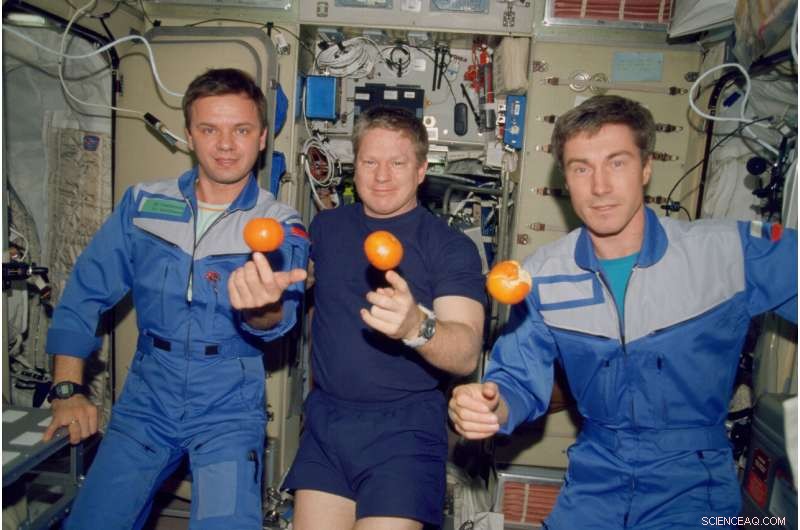
På det här fotot från NASA, besättningsmedlemmarna på Expedition 1 poserar med färska apelsiner ombord på Zvezda Service Module på den internationella rymdstationen som kretsar runt jorden den 4 december, 2000. På bilden, från vänster, är kosmonauten Yuri P. Gidzenko, Sojuz-befälhavare; astronaut Bill Shepherd, uppdragschef; och kosmonauten Sergei K. Krikalev, flygingenjör. (NASA via AP)
"Det är 500 ton saker som zoomar runt i rymden, de flesta som aldrig rörde varandra förrän de kom upp där och bultade upp, "Shepherd berättade för Associated Press. "Och allt har körts i 20 år med nästan inga stora problem."
"Det är ett verkligt bevis på vad som kan göras i den här typen av program, " han sa.
Herde, 71, är sedan länge pensionerad från NASA och bor i Virginia Beach, Virginia. Krikalev, 62, och Gidzenko, 58, har stigit i den ryska rymdraden. Båda var inblandade i lanseringen av den 64:e besättningen i mitten av oktober.
Det första de tre gjorde när de anlände till den mörklagda rymdstationen den 2 november, 2000, tände ljuset, som Krikalev mindes som "mycket minnesvärd". Sedan värmde de vatten för varma drycker och aktiverade den ensamma toaletten.
"Nu kan vi leva, " Gidzenko minns att Shepherd sa. "Vi har ljus, vi har varmvatten och vi har toalett."

I denna 31 oktober, 2000, filbild från video tillhandahållen av NASA, ett rökmoln omger Soyuz-raketen sekunder innan lyftet från Baikonur Cosmodrome i Kazakstan, med de första invånarna i den internationella rymdstationen. Två dagar senare, USA:s astronaut Bill Shepherd, och ryska kosmonauterna Sergej Krikalev, and Yuri Gidzenko arrived at the space station. (NASA via AP, Fil)
The crew called their new home Alpha, but the name didn't stick.
Although pioneering the way, the three had no close calls during their nearly five months up there, Shepherd said, and so far the station has held up relatively well.
NASA's top concern nowadays is the growing threat from space junk. This year, the orbiting lab has had to dodge debris three times.
As for station amenities, astronauts now have near-continuous communication with flight controllers and even an internet phone for personal use. The first crew had sporadic radio contact with the ground; communication blackouts could last hours.
While the three astronauts got along fine, tension sometimes bubbled up between them and the two Mission Controls, in Houston and outside Moscow. Shepherd got so frustrated with the "conflicting marching orders" that he insisted they come up with a single plan.

In this Oct. 31, 2000, photo provided by NASA, Expedition 1 crew members, from top, Sergei K. Krikalev, Bill Shepherd and Yuri P. Gidzenko pose for final photos prior to their launch aboard a Soyuz rocket to the International Space Station from the Baikonur Cosmodrome in Kazakhstan. Två dagar senare, they swung open the space station doors, clasping their hands in unity. Thus began 20 years of international cooperation and a steady stream of crew from around the world. (NASA via AP)
"I've got to say, that was my happiest day in space, " he said during the panel discussion.
With its first piece launched in 1998, the International Space Station already has logged 22 years in orbit. NASA and its partners contend it easily has several years of usefulness left 260 miles (400 kilometers) up.
The Mir station—home to Krikalev and Gidzenko in the late 1980s and 1990s—operated for 15 years before being guided to a fiery reentry over the Pacific in 2001. Russia's earlier stations and America's 1970s Skylab had much shorter life spans, as did China's much more recent orbital outposts.
Astronauts spend most of their six-month stints these days keeping the space station running and performing science experiments. A few have even spent close to a year up there on a single flight, serving as medical guinea pigs. Shepherd and his crew, däremot barely had time for a handful of experiments.

This photo provided by NASA shows a Progress supply ship that arrived on Nov. 18, 2000 to link up to the International Space Station, bringing Expedition 1 commander Bill Shepherd, pilot Yuri P. Gidzenko and flight engineer Sergei K. Krikalev two tons of food, Kläder, hardware and holiday gifts from their families. (NASA via AP)
The first couple weeks were so hectic—"just working and working and working, " according to Gidzenko—that they didn't shave for days. It took awhile just to find the razors.
Even back then, the crew's favorite pastime was gazing down at Earth. It takes a mere 90 minutes for the station to circle the world, allowing astronauts to soak in a staggering 16 sunrises and 16 sunsets each day.
The current residents—one American and two Russians, just like the original crew—plan to celebrate Monday's milestone by sharing a special dinner, enjoying the views of Earth and remembering all the crews who came before them, especially the first.
But it won't be a day off:"Probably we'll be celebrating this day by hard work, " Sergei Kud-Sverchkov said Friday from orbit.
One of the best outcomes of 20 years of continuous space habitation, according to Shepherd, is astronaut diversity.

På det här fotot från NASA, Expedition 1 flight engineer Sergei K. Krikalev works in the Zvezda Service Module, with his feet anchored in a tunnel hatchway, aboard the International Space Station on Dec. 6, 2000. The space station was cramped and humid with just three rooms when the first crew moved in. Conditions were primitive, compared with now, and the three spent most of their time coaxing equipment to work. In the past twenty years, the space station has morphed into a complex that's almost as long as a football field, with eight miles (13 kilometers) of electrical wiring and three high-tech labs. (NASA via AP)
While men still lead the pack, more crews include women. Two U.S. women have served as space station skipper. Commanders typically are American or Russian, but have also come from Belgium, Tyskland, Italy, Canada and Japan. While African-Americans have made short visits to the space station, the first Black resident is due to arrive in mid-November on SpaceX's second astronaut flight.
Massive undertakings like human Mars trips can benefit from the past two decades of international experience and cooperation, Shepherd said.
"If you look at the space station program today, it's a blueprint on how to do it. All those questions about how this should be organized and what it's going to look like, the big questions are already behind us, " he told the AP.
Ryssland, till exempel, kept station crews coming and going after NASA's Columbia disaster in 2003 and after the shuttles retired in 2011.

På det här fotot från NASA, Expedition 1 mission commander Bill Shepherd works in a docking compartment aboard the International Space Station on Dec. 5, 2000. The International Space Station was a cramped, humid, puny three rooms when the first crew moved in. Twenty years and 241 residents later, the complex has a domed lookout, three toilets, six sleeping compartments and 10 rooms, depending on how you count. (NASA via AP)

This photo provided by NASA shows the new International Space Station after the crew of the Space Shuttle Endeavour captured the Zarya Control Module, vänster, and mated it with the Unity Node, höger, inside the Shuttle's payload bay. This photo was taken after Endeavour undocked from the space station on Dec. 13, 1998, for the return to Earth. Almost two years later, the first crew—American Bill Shepherd and Russians Sergei Krikalev and Yuri Gidzenko—blasted off from Kazakhstan on Oct. 31, 2000, en route to the space station. Thus began 20 years of international cooperation and a steady stream of crew from around the world. (NASA via AP)
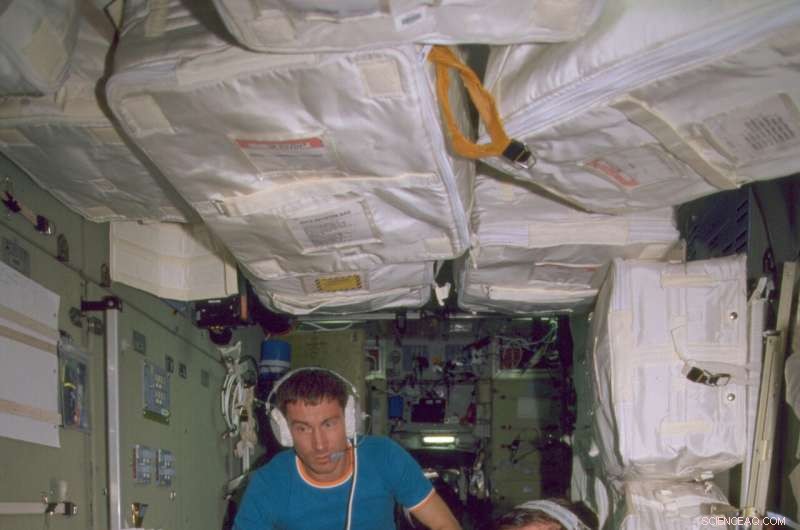
På det här fotot från NASA, Expedition 1 crew members Sergei Krikalev, vänster, and Yuri Gidzenko work in the Zvezda Service Module onboard the International Space Station on Nov. 8, 2000. The first crew, Russians Krikalev and Gidzenko along with American Bill Shepherd, spent most of their time coaxing equipment to work in the cramped and humid three-room space station. Twenty years and 241 residents later, the complex is almost as long as a football field, with six sleeping compartments, three toilets, a domed lookout and three high-tech labs. (NASA via AP)

This photo provided by NASA shows the International Space Station as seen from Space Shuttle Atlantis during mission STS-106, which delivered supplies and performed maintenance in September 2000. The first crew of the space station—American Bill Shepherd and Russians Sergei Krikalev and Yuri Gidzenko—arrived less than two months later. Thus began 20 years of international cooperation and a steady stream of crew from around the world. (NASA via AP)

This Oct. 20, 2000 photo made available by NASA shows the International Space Station after separation of the Space Shuttle Discovery. Backdropped against the blackness of space, the Z1 Truss structure and its antenna, as well as the new pressurized mating adapter (PMA-3), are visible in the foreground. (NASA via AP)
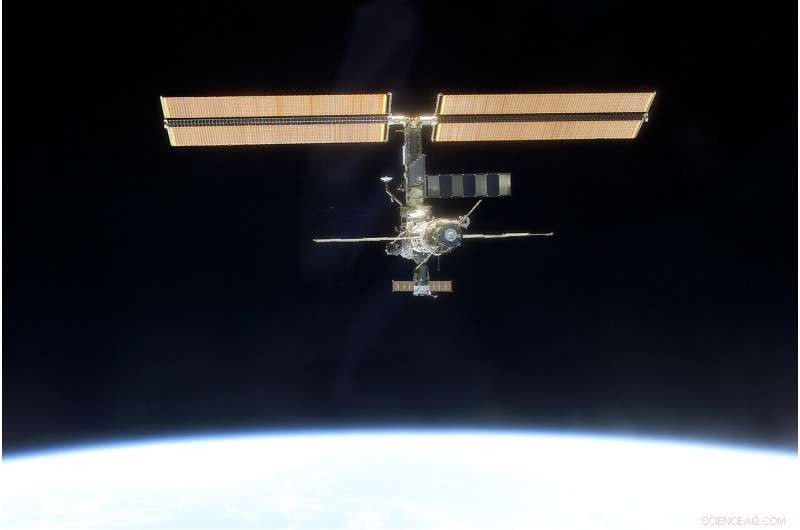
På det här fotot från NASA, the International Space Station, backdropped against black space above Earth's horizon, is seen from the Space Shuttle Discovery on March 19, 2001, after a new crew comprised of cosmonaut Yury Usachev and astronauts James Voss and Susan Helms began several months aboard the station. In the early days of the station, it was a cramped and humid, with just three rooms. It's much larger now, with six sleeping compartments, three toilets, a domed lookout and three high-tech labs. (NASA via AP)

This photo provided by NASA shows the International Space Station as seen from Space Shuttle Endeavour as the two spacecraft begin their relative separation on Nov. 28, 2008. Twenty years after the first crew arrived at the space station, the spacecraft has hosted 241 residents and grown from three cramped and humid rooms to a complex almost as long as a football field, with six sleeping compartments, three toilets, a domed lookout and three high-tech labs. (NASA via AP)

This photo provided by NASA shows the International Space Station as seen from the Space Shuttle Atlantis after the station and shuttle began their post-undocking relative separation on May 23, 2010. Twenty years after the first crew arrived, the space station has hosted 241 residents and grown from three cramped and humid rooms to a complex almost as long as a football field, with six sleeping compartments, three toilets, a domed lookout and three high-tech labs. (NASA via AP)

På det här fotot från NASA, backdropped against clouds over Earth, the International Space Station is seen from Space Shuttle Discovery as the two orbital spacecraft accomplish their relative separation on March 7, 2011. From the first crew to the most recent, the No. 1 pastime aboard the station is gazing down at Earth. It takes just 90 minutes to circle the world, allowing crews to soak in a staggering 16 sunrises and 16 sunsets every day. (NASA via AP)
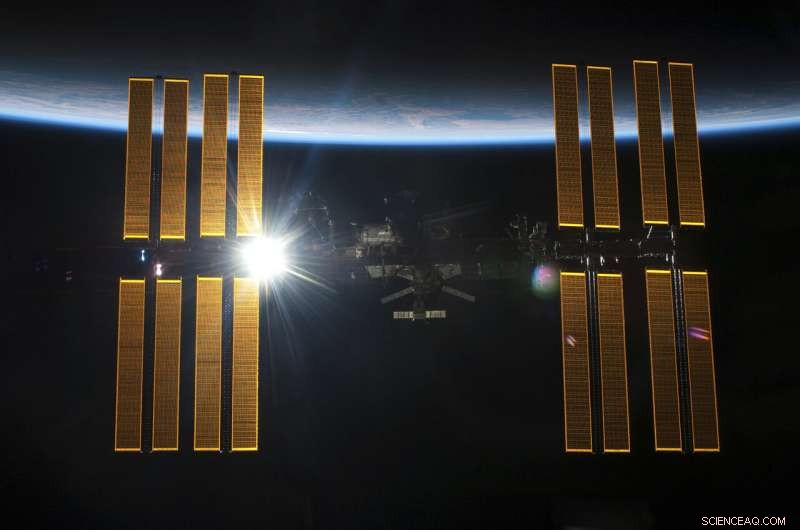
På den här bilden från NASA, the International Space Station is seen from the Space Shuttle Endeavour on May 29, 2011, after the station and shuttle began their post-undocking relative separation. It takes just 90 minutes for the space station to circle the world, allowing crews to see 16 sunrises and 16 sunsets every day. (NASA via AP)

På det här fotot från NASA, the International Space Station is seen from the Space Shuttle Atlantis as the two spacecraft perform their relative separation on July 19, 2011. Above and to the right of the space station is the moon far in the distance. (NASA via AP)

In this photo provided by NASA/Roscosmos, the International Space Station floats above the Earth as seen from a Soyuz spacecraft after undocking on Oct. 4, 2018. NASA astronauts Andrew Feustel and Ricky Arnold and Roscosmos cosmonaut Oleg Artemyev executed a fly around of the orbiting laboratory to take pictures of the station before returning home after spending 197 days in space. Twenty years after the first crew arrived, the space station has hosted 241 residents. (NASA/Roscosmos via AP)
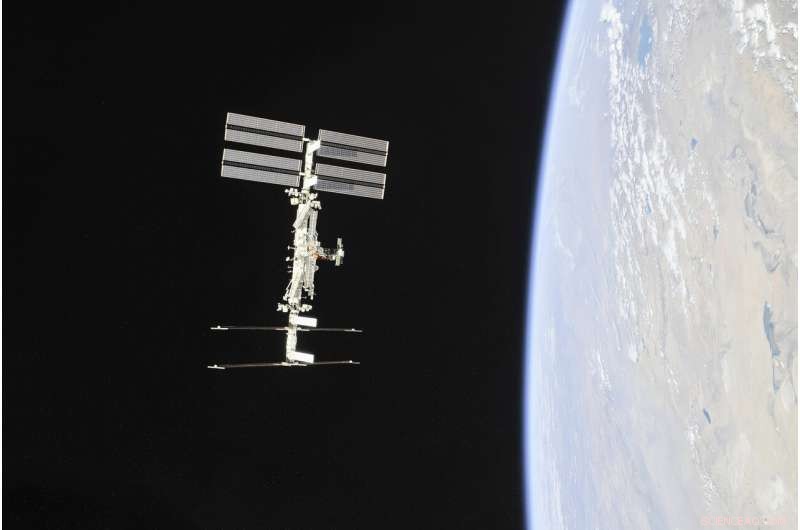
In this photo provided by NASA/Roscosmos, the International Space Station continues its orbit around the Earth as seen from a Soyuz spacecraft departing with NASA astronauts Andrew Feustel and Ricky Arnold and Roscosmos cosmonaut Oleg Artemyev, who had spent 197 days in space. From the first crew to the most recent, the No. 1 pastime aboard the station is gazing down at Earth. It takes just 90 minutes to circle the world, allowing crews to soak in a staggering 16 sunrises and 16 sunsets every day. (NASA/Roscosmos via AP)
When Shepherd and his crewmates returned to Earth aboard shuttle Discovery after nearly five months, his main objective had been accomplished.
"Our crew showed that we can work together, " han sa.
© 2020 The Associated Press. Alla rättigheter förbehållna. Detta material får inte publiceras, utsända, omskrivs eller omdistribueras utan tillstånd.